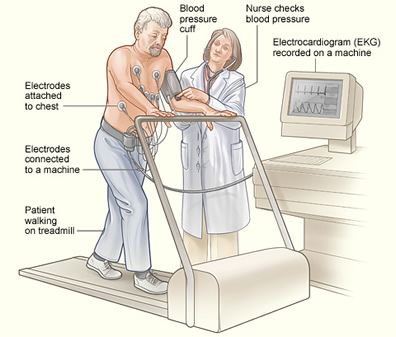THREDMILL (TMT)
Stress testing gives your doctor information about how your heart works during physical stress. Some heart problems are easier to diagnose when your heart is working hard and beating fast. During a stress test, you exercise (walk or run on a treadmill or pedal a bicycle) to make your heart work hard and beat fast. Tests are done on your heart while you exercise. You may have arthritis or another medical problem that prevents you from exercising during a stress test. If so, your doctor may give you medicine to make your heart work hard, as it would during exercise. This is called a pharmacological (FAR-ma-ko-LOJ-i-kal) stress test.
OVERVIEW
Doctors usually use stress testing to help diagnose coronary heart disease (CHD), also called coronary artery disease. They also use stress testing to see how severe CHD is in people who have it.
CHD is a condition in which a fatty material called plaque (plak) builds up in the coronary arteries. These arteries supply oxygen-rich blood to your heart.
Plaque narrows the arteries and reduces blood flow to your heart muscle. It also makes it more likely that blood clots will form in your arteries. Blood clots can partly or completely block blood flow. This can lead to chest pain or a heart attack.
You may not have any signs or symptoms of CHD when your heart is at rest. But when your heart has to work harder during exercise, it needs more blood and oxygen. Narrowed arteries can't supply enough blood for your heart to work well. As a result, signs and symptoms of CHD may only occur during exercise.
A stress test can detect the following problems, which may suggest that your heart isn't getting enough blood during exercise.
1.) Abnormal changes in your heart rate or blood pressure
2.) Symptoms such as shortness of breath or chest pain, which are particularly important if they occur at low levels of exercise
3.) Abnormal changes in your heart's rhythm or electrical activity
4.) During a stress test, if you can't exercise for as long as what's considered normal for someone your age, it may be a sign that not enough blood is flowing to your heart. However, other factors besides CHD can prevent you from exercising long enough (for example, lung disease, anemia, or poor general fitness).
A stress test also may be used to assess other problems, such as heart valve disease or heart failure.
WHAT TO EXPECT BEFORE STRESS TESTING
Standard stress testing often is done in a doctor's office. Imaging stress testing usually is done at a hospital. Be sure to wear athletic or other shoes in which you can exercise comfortably. You may be asked to wear comfortable clothes, or you may be given a gown to wear during the test.
Your doctor may ask you not to eat or drink anything but water for a short time before the test. If you're diabetic, ask your doctor whether you need to adjust your medicines on the day of your test.
For some stress tests, you can't drink coffee or other caffeinated drinks for a day before the test. Certain over-the-counter or prescription medicines also may interfere with some stress tests. Discuss with your doctor whether you need to avoid certain drinks or food or change how you take your medicine before the test.
If you use an inhaler for asthma or other breathing problems, bring it to the test. Make sure you let the doctor know that you use it.
WHAT TO EXPECT DURING STRESS TESTING
During all types of stress testing, a technician or nurse will always be with you to closely check your health status.
Before you start the "stress" part of a stress test, the technician or nurse will put sticky patches called electrodes on the skin of your chest, arms, and legs. To help an electrode stick to the skin, the technician or nurse may have to shave a patch of hair where the electrode will be attached.
The electrodes are connected to an EKG (electrocardiogram) machine. This machine records your heart's electrical activity and shows how fast your heart is beating and the heart's rhythm (steady or irregular). An EKG also records the strength and timing of electrical signals as they pass through each part of your heart.
The technician or nurse will put a blood pressure cuff on your arm to check your blood pressure during the stress test. (The cuff will feel tight on your arm when it expands every few minutes.) Also, you may be asked to breathe into a special tube so the gases you breathe out can be measured.
After these preparations, you'll exercise on a treadmill or stationary bicycle. If such exercise poses a problem for you, you may instead turn a crank with your arms. During the test, the exercise level will get harder. You can stop whenever you feel the exercise is too much for you.


Dr.Gurneet Singh Chhina
M.D. Radiodiagnosis
( PGI Consultant Radiologist )
